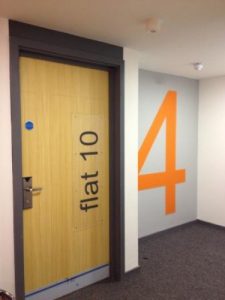Health and Safety Considerations for Student Accommodation
 In recent years, a University education has become more popular than ever and there are a growing number of students who demand high quality accommodation. Living in a large modern building, particularly in a city centre, is usually very appealing for students and proves popular; in fact, purpose-built student accommodation blocks are popping up across the country. These types of property are usually a profitable proposition for developers due to the steady stream of potential new tenants they present. However, as with any other property type, building owners will need to consider the health and safety aspects of the building and will need to have risk assessments carried out to comply with the law. Below, we have outlined some of the health and safety issues that should be considered within student accommodation, starting with fire safety.
In recent years, a University education has become more popular than ever and there are a growing number of students who demand high quality accommodation. Living in a large modern building, particularly in a city centre, is usually very appealing for students and proves popular; in fact, purpose-built student accommodation blocks are popping up across the country. These types of property are usually a profitable proposition for developers due to the steady stream of potential new tenants they present. However, as with any other property type, building owners will need to consider the health and safety aspects of the building and will need to have risk assessments carried out to comply with the law. Below, we have outlined some of the health and safety issues that should be considered within student accommodation, starting with fire safety.
Fire Safety
Often, student accommodation consists of unrelated occupiers living independently from one another and sharing the common areas of the building; such as a kitchen, living area or shared corridors. In accordance with the 2005 Fire Safety Order the responsible person for the building will need to have a Fire Risk Assessment carried out in these communal areas, carried out by a competent person. Some of the fire safety aspects that should be considered include whether the smoke detectors are being regularly tested, and whether fire extinguishers and emergency lighting is regularly being checked and serviced.

The risk assessor will also look at whether there has been sufficient communication with the students regarding fire safety within in communal areas, their individual flat entrance doors, and what to do in the event of a fire. The responsible person for the building should be ensuring that a fire evacuation plan is put in place and is communicated to the students who reside in the building.
They also need to make sure that fire doors are inspected to ensure they meet the FD30s requirements. To help avoid risks, information and guidance on fire safety should be provided to students at the beginning of their occupancy, particularly because kitchen fires in student accommodation are more likely to occur at the beginning of the academic year.
Furthermore, student accommodation that is 10-storeys or higher legally require sprinklers. However, since Grenfell, industry bodies have called for sprinklers to be required in all new and refurbished flats, including student accommodation. In addition to this, some buildings used for student accommodation may have ACM cladding, similar to that found on the Grenfell tower and therefore require special consideration prior to its replacement.
Health and Safety
In accordance with the Health and Safety at Work Act 1974 and The Management of Health & Safety at Work Regulations 1999, Health and Safety Risk Assessments are also required for the communal areas of student accommodation. This can often be carried out at the same time as the Fire Risk Assessment and will look at the general health and safety management of the building.
One of the aspects of safety management considered is safety communication for contractors and contractor vetting. Those responsible for ensuring the safety of the student block should have a system in place to make sure that site safety rules and relevant risk assessments are issued to contractors prior to any work being carried out. They should also ensure that all contractors employed to work on site have been vetted for Health & Safety competency; which they can do so via a third-party accreditation scheme such as Safe4site.
The dutyholder for the block will also need to ensure that there are sufficient accident reporting procedures and that property inspections are being carried out on a regular basis, with records held.
Legionella
A highly important aspect of safety in student accommodation is water hygiene, in particular the risk from legionella bacteria developing into the deadly legionnaire’s disease.
It is a legal duty for Landlords – under the Control of Substances Hazardous to Health Regulations 2002 and Approved Code of Practice (L8) – to assess the risk of Legionella exposure in their properties and to control this risk. In order to do so, a Legionella Risk Assessment should be carried out by a competent person and if any risks are identified, appropriate measures will need to be implemented in order to control it.
Student accommodation is likely to be left unoccupied for long periods, outside of term time. Therefore, the risk from legionella bacteria developing can be high, if water is left to stagnate.
To manage the risk, the responsible person should put in place a flushing regime, which basically means turning on taps for about 5 minutes before use, where they have been left unused for a long period of time. Shower heads should also be regularly descaled since scale is an ideal food source for Legionella bacteria and Water Monitoring should be carried out; preferably every 6 months.

For further advice and guidance on health, safety and fire in student accommodation, contact the team today.


